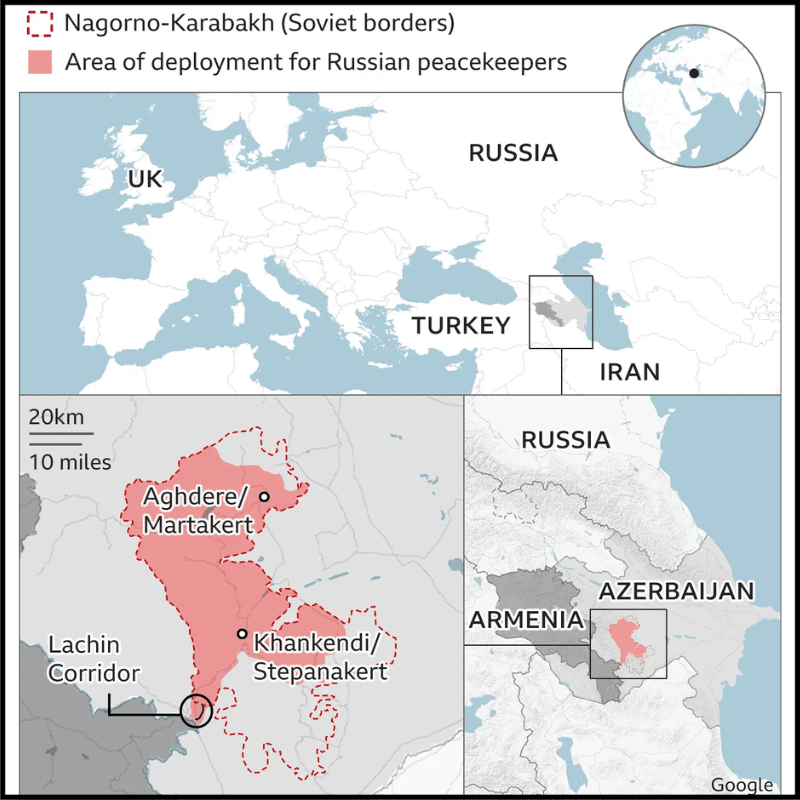
The Nagorno-Karabakh conflict, often described as a “frozen conflict” that periodically thawed into bloody confrontations, appears to have reached a historic turning point in 2025. Read here to learn more about the conflict and the peace deal.
The signing of the US-brokered peace agreement between Armenia and Azerbaijan in July 2025 marks a potential end to one of the most persistent territorial disputes in the post-Soviet space – the Nagorno-Karabakh conflict.
For nearly four decades in its modern form (and over a century if one counts its imperial-era roots), this mountainous enclave in the South Caucasus has been the flashpoint of wars, forced migrations, and geopolitical manoeuvring involving Russia, Turkey, Iran, and now the United States.
Geographical Context
Nagorno-Karabakh is a landlocked mountainous region in the South Caucasus, nestled between the Black Sea and the Caspian Sea.
- Political Status: Internationally recognised as part of Azerbaijan, but historically inhabited largely by ethnic Armenians.
- Strategic Importance: The Caucasus forms a key land corridor linking Europe and Asia, and is rich in oil, gas, and transit routes, making any instability in this region a matter of global concern.
Historical Background of the Nagorno-Karabakh Conflict

Imperial Era (Pre-1920s)
- Following the collapse of the Russian Empire in 1917, Armenia and Azerbaijan emerged as short-lived independent republics.
- Both laid claim to Nagorno-Karabakh, leading to violent clashes even before Soviet control.
Soviet Period (1923–1980s)
- In 1923, the Soviet Union designated Nagorno-Karabakh as an autonomous oblast within the Azerbaijan SSR, despite its Armenian majority.
- This administrative decision sowed the seeds for future disputes, as Armenians felt culturally and politically tied to Armenia.
Late Soviet Period (1988–1991)
- With the USSR weakening, the Nagorno-Karabakh regional legislature voted to join Armenia.
- Azerbaijan opposed the move; inter-ethnic violence erupted, including pogroms against Armenians in Sumgait (1988) and Baku (1990).
Phases of the Nagorno-Karabakh Conflict
First Nagorno-Karabakh War (1988–1994)
- Triggered by the region’s unilateral declaration of independence.
- Outcome: Armenian-backed forces captured Nagorno-Karabakh and 7 surrounding districts (~20% of Azerbaijan’s territory).
- Ceasefire: The 1994 Bishkek Protocol brokered by Russia established a fragile truce but no final settlement.
The Stalemate Years (1994–2020)
- Multiple mediation attempts, primarily by the OSCE Minsk Group (comprising Russia, the US, and France), have failed to resolve the issue.
- Skirmishes and flare-ups, notably the April 2016 “Four-Day War”, highlighted the volatility.
Second Nagorno-Karabakh War (2020)
- Azerbaijan, aided by Turkish military technology (including drones), launched a decisive offensive.
- Result: Azerbaijan regained all 7 districts and about one-third of Nagorno-Karabakh.
- Ceasefire: Russia brokered a deal deploying 1,960 peacekeepers.
The 2023 Lightning Offensive
- Azerbaijan took full control of Nagorno-Karabakh in a one-day military operation.
- Over 1 lakh ethnic Armenians fled to Armenia, effectively ending Armenian self-rule in the enclave.
Nagorno-Karabakh conflict timeline
Year / Period |
Event |
Significance / Outcome |
1917–1920 |
Collapse of the Russian Empire after the Bolshevik Revolution. Armenia & Azerbaijan both claim Nagorno-Karabakh. |
Birth of the territorial dispute. |
1923 |
Soviet Union incorporates Nagorno-Karabakh as an autonomous oblast within the Azerbaijan SSR, despite the Armenian majority. |
Seeds of discontent among ethnic Armenians. |
Late 1980s |
As the USSR weakens, Nagorno-Karabakh votes to join Armenia; Azerbaijan rejects. |
Escalation of ethnic violence & pogroms. |
1988–1994 |
First Nagorno-Karabakh War between Armenia & Azerbaijan. |
Armenia-backed forces take control of Nagorno-Karabakh + 7 surrounding districts (20% of Azerbaijan’s territory). |
1994 |
Bishkek Protocol (Ceasefire) brokered by Russia. |
Ceasefire holds intermittently; no final settlement. |
1994–2020 |
Stalemate period; OSCE Minsk Group mediates. |
Frequent border skirmishes; deepening mistrust. |
April 2016 |
Four-Day War – brief but intense fighting. |
Azerbaijan regains small areas; highlights fragility of ceasefire. |
Sept–Nov 2020 |
Second Karabakh War – Azerbaijan launches major offensive with Turkish support (incl. drones). |
Azerbaijan recaptures 7 districts and about 1/3rd of Nagorno-Karabakh. |
Nov 2020 |
Russia-brokered peace deal signed. |
Deployment of around 1,960 Russian peacekeepers to monitor the corridor. |
Sept 2023 |
Azerbaijan conducts lightning offensive; Armenian forces in Nagorno-Karabakh surrender. |
Baku reasserts full control; 1 lakh+ ethnic Armenians flee to Armenia. |
July 2025 |
US-brokered Peace Agreement was signed in Washington. |
Armenia & Azerbaijan recognise each other’s territorial integrity; agree to transit corridor (“Trump Route”). |
US-Brokered Armenia–Azerbaijan Peace Agreement
- Mutual Recognition of Territorial Integrity: Both nations formally relinquish territorial claims over each other.
- Non-Aggression Pact: Ban on the use of force; commitment to settle disputes under international law.
- US-Brokered Economic Clause: The US secures exclusive rights to develop the “Trump Route for International Peace and Prosperity” transit corridor through the South Caucasus.
US Strategic Interests
- Peace deal enhances US influence in the South Caucasus, a region of strategic importance for energy transit, trade, and geopolitical balancing between Russia, Turkey, and Iran.
- The Trump Route corridor strengthens Western-led transport links, bypassing Russia.
India’s Position
- Supports the peace agreement as both Armenia and Azerbaijan are part of the International North-South Transport Corridor (INSTC), critical for India–Russia connectivity.
- Friendship & Cooperation Treaty with Armenia (1995) underlines long-standing bilateral goodwill.
- Balances ties with Azerbaijan due to energy trade and strategic connectivity.
Significance
- Ends nearly four decades of armed conflict in Nagorno-Karabakh.
- Reduces Russian influence in the region amid Moscow’s Ukraine focus.
- Opens avenues for trade, energy, and regional stability.
Conclusion
The Nagorno-Karabakh conflict appears to have reached a historic turning point in 2025.
However, peace in the Caucasus will depend not only on the letter of the agreement but on genuine reconciliation, trust-building, and equitable development.
For India, the resolution offers both strategic opportunities and diplomatic balancing challenges in a region where history runs deep and geopolitics never sleeps.
Related articles:






Leave a Reply